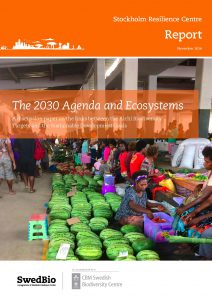 Story highlights
Story highlights
- Well-functioning ecosystems are relevant to achieve all the SDGs.
- There are strong overlaps between the Aichi Biodiversity Targets and the SDGs, but gaps also exist.
- Further inclusive in-depth gap analysis is needed to fully understand how the Aichi Biodiversity Targets and the SDGs can be mutually supportive.
Biodiversity and ecosystem services are essential to achieve the 2030 Agenda for Sustainable Development.
To accomplish the 2030 Agenda, there is however a need for improved mainstreaming of enhanced conservation and sustainable use of biodiversity and ecosystems in development decisions, sectors and actions. Mainstreaming is presently also the central theme under the Convention on Biological Diversity Maria Schultz, Director of SwedBio and Policy Director of SRC
This Discussion Paper outlines the links between the Aichi Biodiversity Targets under the Convention on Biological Diversity (CBD) and the Sustainable Development Goals (SDGs) under the 2030 Agenda. The two processes can be mutually supportive for effective implementation. By analysing the wording of both the Aichi Biodiversity Targets and the SDGs, the overlap and synergy between the two processes can be seen.
Using a scoring system based on whether Aichi Biodiversity Target elements are directly, indirectly or not considered across the suite of SDG Goals and Targets, it was found that three of the Aichi Biodiversity Targets (2 Biodiversity values integrated, 16 Nagoya Protocol in force and operational, and 20 Financial resources from all sources increased) are fully covered under the SDGs, while only one (17 NBSAPs adopted as policy instrument) is not covered at all. All elements of five Targets (3 Incentives reformed, 5 Habitat loss halved or reduced, 6 Sustainable management of marine living resources, 12 Extinction prevented and 18 Traditional knowledge respected) are indirectly considered in the SDGs, while the elements of one (11 Protected areas increased and improve) is either indirectly covered or absent. The elements of each of the remaining nine are either directly or indirectly considered.
The kind of analysis developed in this paper aids understanding of such synergies, which can be helpful in the implementation of both processes, but the Paper is just a first step.
Further inclusive in-depth analysis of gaps and synergies is needed to understand the links between the 2030 Agenda and the post-2020 strategic plan of the CBD, and the implications for effective ecosystem management Tristan Tyrrell, Programme Officer at SwedBio

 Read the report: The 2030 Agenda and Ecosystems
Read the report: The 2030 Agenda and Ecosystems Private: Tristan Tyrrell
Private: Tristan Tyrrell